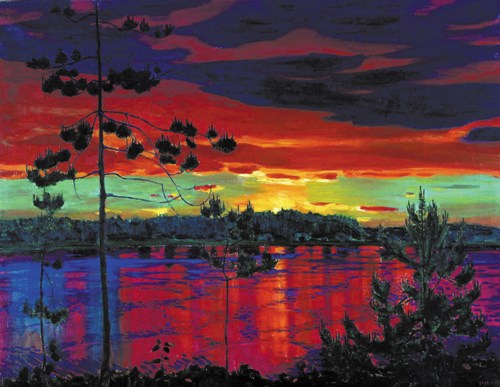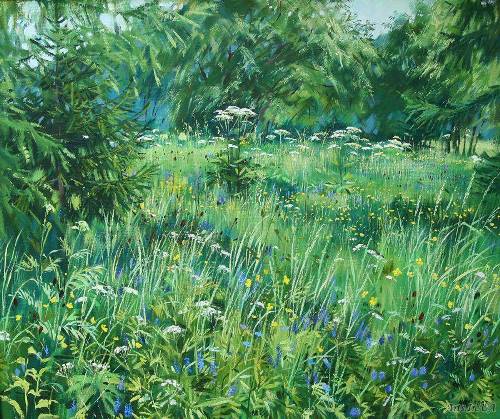Russian painter Nicholas Roerich

Armageddon. Russian painter Nicholas Roerich (October 9, 1874 Saint Petersburg, Russia – December 13, 1947 Himachal Pradesh, India)
Russian painter Nicholas Roerich – one of the most prominent figures of Russian Symbolism and Art Nouveau, writer, archaeologist, theosophist, enlightener, philosopher, and public figure. He moved his philosophy onto the canvas, which are in the interest of the whole world. Nicholas Konstantinovich Roerich was born into the family of a well-known lawyer in St. Petersburg on September 27 (October 9), 1874. After finishing Karl Mai’s gymnasium, he entered the Academy of Arts in 1893, where he worked with Pavel Chistyakov and Arkhip Kuinji till 1897, simultaneously studying law at St. Petersburg University.
In 1900, he took a course in painting at Fernand Cormon’s studio in Paris. In 1901, he was appointed Secretary of the Society for the Encouragement of the Arts, and in 1906 director of its school of drawing. In 1909, he was elected a Fellow of the Russian Academy of Arts, and in the following year, Chairman of the revived World of Art society.
In 1903 and 1904 he made an extensive tour of old Russian towns, and in 1906 traveled to Germany, Italy, France, and Sweden to familiarize himself with foreign experience in the sphere of artistic education. In 1916, he moved to Karelia. He first exhibited in 1900, participating in World of Art shows from 1902 on.

Nicholas Roerich. Heavenly Battle. Version of the 1909 picture. 1912. Tempera on cardboard. Russian museum, St. Petersburg
1902 Building a Town. A Sacred Place. Guests from Overseas. Combat (pastel)
1903 Building the Boats. Monastery. Siberian Frieze. Studies done during the journey to the old Russian towns of Bogoliubovo, Vladimir, Grodno, Izborsk, Kostroma, Pskov, Pechora, Rostov the Great, Smolensk, Suzdal, Yuriev-Podolsky, Yaroslavl, etc.
1904 St. Boris and St.Gleb. Studies done while visiting the old Russian towns of Valdai, Zvenigorod, Kalyazin, Pskov, Tver, and Uglich. The Battle of Alexander Nevsky with Yarle Berger: Skewtch for a Mosaic (gouache), Ancient Life, sketch (pastel). Nomads (pastel). Round Dances (gouache). The Stone Age (majolica). Sketches for the Talashkino workshops.
1905 The Treasure of The Angels. Birches (tempera and pastel). The Patrol. Sorcerers (gouache and pastel). Pskov. The Slavs on the Dnieper (tempera). The North. The Valkyries in Flight: Sketch for the Battle composition (pencil). Cartoons for majolica friezes and pediments of the house of the former Rossiya Insurance Society (gouache). Illustrations for the works of Maeterlinck.
1906 Self-Portrait (sketch). The Pomors. Day-break. Battle. The Serpent Woman. Sorcerer. Bear Hunt. Studies done while traveling in Italy and Switzerland (pastel, tempera, and gouache). Sketches for mosaics in the Parkhomovka village church near Kiev (tempera). Head of the Saviour. The Intercession of the Virgin. Sketches for mosaics in the Church-at-the-Gunpowder-Factories (now the village of Morozovka) (tempera). Illustrations for Pushkin’s Ruslan and Lyudmila.
1907 The Otherworld Lords. The Stone Age (frieze for majolica). Iconostasis for the Kamensky family’s chapel in the Perm Convent. Town (tempera). The Prophet Elijah (tempera and pastel). Three Young Hebrews in the Blazing Furnace (tempera and gouache). The Song of the Viking (tempera). The Pskov-Pechorsky Monastery (tempera and pastel). The Seven Shivery Sisters (two versions, one tempera, the other, pastel). Set designs for The Three Magi at St. Petersburg’s Antique Theater and for Wagner’s The Valkyrie, Finnish sketchbook. Raven Perched on a Dead Horse, an illustration for I.Nikitin’s Neither Cloud Nor Wind (India Ink and pencil).
Before completely leave for East and search for Shambhala he painted landscapes of old Russian cities of Pskov, Rostov Veliky, Izborsk and others, engaged in theatrical design and scenography.
During the revolution, Nicholas Roerich began to travel, first went to Finland and then to the United States, then begins his famous Trans-Himalayan expedition. The result of this expedition was a lot of books and paintings painted in tempera. It is through his paintings people could get acquainted with Asia and its wonders: majestic mountain peaks, magic mysterious places, mystical Shambhala.
In 1924, in New York opened a museum dedicated to Roerich. In Moscow there is the International Center of Roerich with its own museum and special department of Roerich’s art at the Museum of Oriental Art.

Nicholas Roerich. The Kiss to Earth. Set design for Stravinsky’s Le Sacre du Printemps (Diaghilev Company). 1912. Tempera on cardboard. Russian Museum, St. Petersburg

Nicholas Roerich. The Polovtsy’s camp. Set design for Act 2 of Borodin’s Prince Igor (Diaghilev Company). 1908. Pastel, charcoal, and gouache on paper mounted on cardboard. Tretyakov Gallery, Moscow

Nicholas Roerich. The Slavs on the Dnieper. 1905. Tempera and pastel on cardboard. Russian Museum, St. Petersburg

Nicholas Roerich. The Polovtsy’s camp. Set design for Act 2 of Borodin’s Prince Igor (Diaghilev Company). 1908. Pastel, charcoal, and gouache on paper mounted on cardboard. Tretyakov Gallery, Moscow

Nicholas Roerich. The Kiss to Earth. Set design for Stravinsky’s Le Sacre du Printemps (Diaghilev Company). 1912. Tempera on cardboard. Russian Museum, St. Petersburg
All images are scanned from the “The world of art movement” illustrated album. 1991
«Мир искусства» Объединение русских художников начала XX века
Альбом (на английском языке)
Издательство «Аврора». Ленинград, 1991
Изд. «1043. (30-00)


















